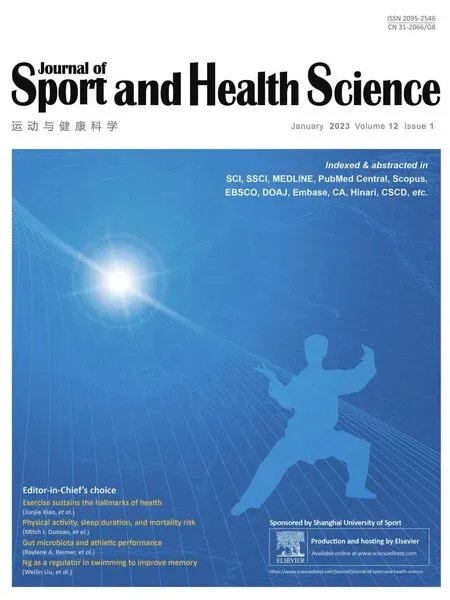Creating Prep to Play PRO for women playing elite Australian football:A how-to guide for developing injury-prevention programs
2023-03-08AnreaBruerAlexDonalsonAnreaMoslerBrookePattersonMelissaHaberfielBenjaminMentiplayPatrickCliftonNicoleLivingstoneOAMKayCrossley
Anrea M.Bruer,Alex Donalson,Anrea B.Mosler,Brooke E.Patterson,Melissa Haberfiel,Benjamin F.Mentiplay,Patrick Clifton,Nicole D.Livingstone OAM,Kay M.Crossley
a La Trobe Sport and Exercise Medicine Research Centre,La Trobe University,Melbourne,VIA 3086,Australia
b Australian IOC Research Centre,La Trobe University,Melbourne,VIA 3086,Australia
c Centre for Sport and Social Impact,La Trobe University,Melbourne,VIA 3086 Australia
d Australian Football League,Melbourne,VIA 3086,Australia
Abstract Background:Developing context-specific,evidence-informed,and implementable injury-prevention programs is challenging.Women playing in the elite Australian Football League for Women are at high risk of serious knee injuries,and no specific injury-prevention program exists.The objective of the study was to describe the collaborative process used to create a context-specific injury-prevention program.Methods:A previously used intervention-development process was modified to incorporate a partnership with the sport’s governing organization and focus on engaging program implementers.The Reach Effectiveness Adoption Implementation and Maintenance(RE-AIM)Sports Setting Matrix guided program development and implementation strategies.Results:The 7-step process,aligned with the RE-AIM Sports Setting Matrix,was applied to develop the injury-prevention program and was titled Prep to Play PRO.The steps were:(Step 1)gaining organizational support and establishing a project partnership;(Step 2)using research evidence and clinical experience;(Step 3)consulting content and context experts;(Step 4)engaging the organization,experts,program implementers,and end-users to concreate the intervention and develop implementation strategies;(Step 5)testing the intervention acceptability and feasibility;(Step 6)evaluating the intervention and implementation strategies against theory;and(Step 7)obtaining feedback from early implementers and end-users.Conclusion:Engaging critical stakeholders at multiple ecological levels(organization,team,and athlete)throughout program development and implementation planning support real-world use.The processes and activities described can guide future sports injury-prevention program development and implementation.
Keywords:Athletes;Elite;Female;Knee Injuries;Sport
1.Introduction
Australian Football(AF)is a team ball sport involving highspeed and sustained running,full-body contact(including bumping and tackling),aerial contests,360˚spatial awareness,jumping and landing,rapid cutting,and deceleration.In 2017,the Australian Football League(AFL)introduced an elite Australian Football League for Women(AFLW).Women playing in this league have a 6 times greater risk of anterior cruciate ligament(ACL)injury than men playing in the equivalent men’s league(known as the AFL).1,2This is the highest sex difference in ACL injury rates across team sports worldwide.2ACL injury risk is complex and multifactorial.3The lack of AF-specific skills among inaugural AFLW players,likely due to limited youth exposure,may contribute to the heightened ACL risk.4
Exercise-based injury-prevention programs can reduce noncontact ACL injury risk by up to 67%,5,6with higher reductions among young female athletes and those with greater program compliance.7,8Despite their known efficacy,the way injuryprevention programs developed is often poorly described and frequently lacks engagement with those responsible for adopting,implementing,and maintaining the programs.Organizational endorsement,understanding the sport-specific injury and implementation context,and incorporating the experiences of key stakeholders are crucial to program success.9-11
In the real world,program success relies on adoption,highfidelity implementation,and maintenance by athletes,program deliverers,coaches,and sporting organizations.12Frameworks have been developed to guide sports injury prevention research and practice.The Translating Research into the Injury Prevention Practice(TRIPP)13framework(Table 1)extends previous attempts at prevention14by identifying and addressing context-specific implementation challenges(i.e.,incorporating a socioecological approach15)to bridge the gap between research and practice.The TRIPP framework outlines a series of necessary activities to optimize injury-prevention program implementation in real-world sport settings.The 6-step intervention development process16was used to create a contextually relevant program,as recommended in TRIPP Step 3(Table 1).This program-development process has been used to plan an injury-prevention program for youth handball(I-PROTECT)17that involves the identification of implementation facilitators by end-users to better inform program development.18This process was also used to develop FootyFirst,which is a program specific to AF in the men’s community and was designed entirely by researchers,with end-users providing feedback on program content and implementation planning only.16Despite high program reach and adoption,implementation was low,19possibly due to lack of end-user involvement in the program’s creation.11,20

Table 1 The TRIPP framework.13
Recently,sports injury research has taken a socioecological approach.17Recognizing that multiple factors interacting across many levels(i.e.,individual athlete,team/coach,sports governing body)may indicate previously unidentified contextual challenges,21we applied the Socio-Ecological Model to the AFLW setting(Fig.1).22We found that the Reach Effectiveness Adoption Implementation Maintenance(RE-AIM)Sports Setting Matrix(SSM)aligns23with the Socio-Ecological Model22and TRIPP Stage 313to guide program creation and help to fill implementation-knowledge gaps.
The AFLW offered a unique context to apply and extend these existing frameworks and to develop an evidence-based injury-prevention program in a real-world elite women’s sport setting.This article describes how we developed Prep to Play PRO in partnership with the governing organization,with afocus on engaging program implementers(mainly high-performance coaches and sports physiotherapists working with female elite athletes)and end-users(AFLW players)(Fig.1).The structure of this article is as follows:the Methods section describes how the previously used 6-step program-development process was modified to develop Prep to Play PRO;the Results section describes how we applied each step during program development and implementation;and the Discussion section explores how the application of each step facilitated program translation and applicability in the AFLW.
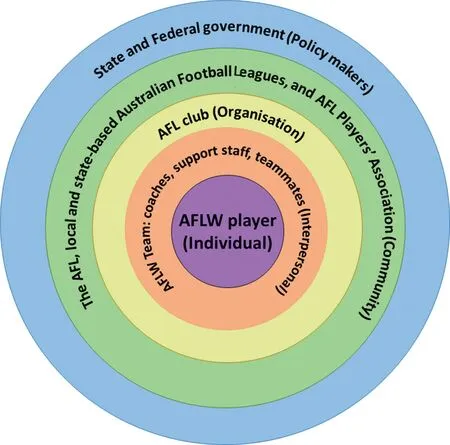
Fig.1.The AFLW mapped to the Socio-Ecological Model.22 AFL=Australian Football League;AFLW=Australian Football League for Women.
2.Methods
2.1.Study design
La Trobe University,Science,Health & Engineering College Human Ethics Sub-Committee approved this study(HEC18354),and the study was undertaken in accordance with the ethical standards as provided in the 1964 Declaration of Helsinki.Individual participants gave informed consents to participate in the study.A multidisciplinary project team made up of clinicians,researchers,and administrators was established to develop Prep to Play PRO and plan its implementation.To better understand the implementation context and enhance program translation into the AFLW setting,a current AFLW athlete(BEP)and AFLW physiotherapist(MH)from 2 different AFLW clubs worked across all project stages.10,24Experience within the project team included:sports physiotherapy(including in the AFLW),implementation science,biomechanics,AFL administration,sports science,clinical and research expertise in injury prevention,health promotion,public health,and an AFLW player.
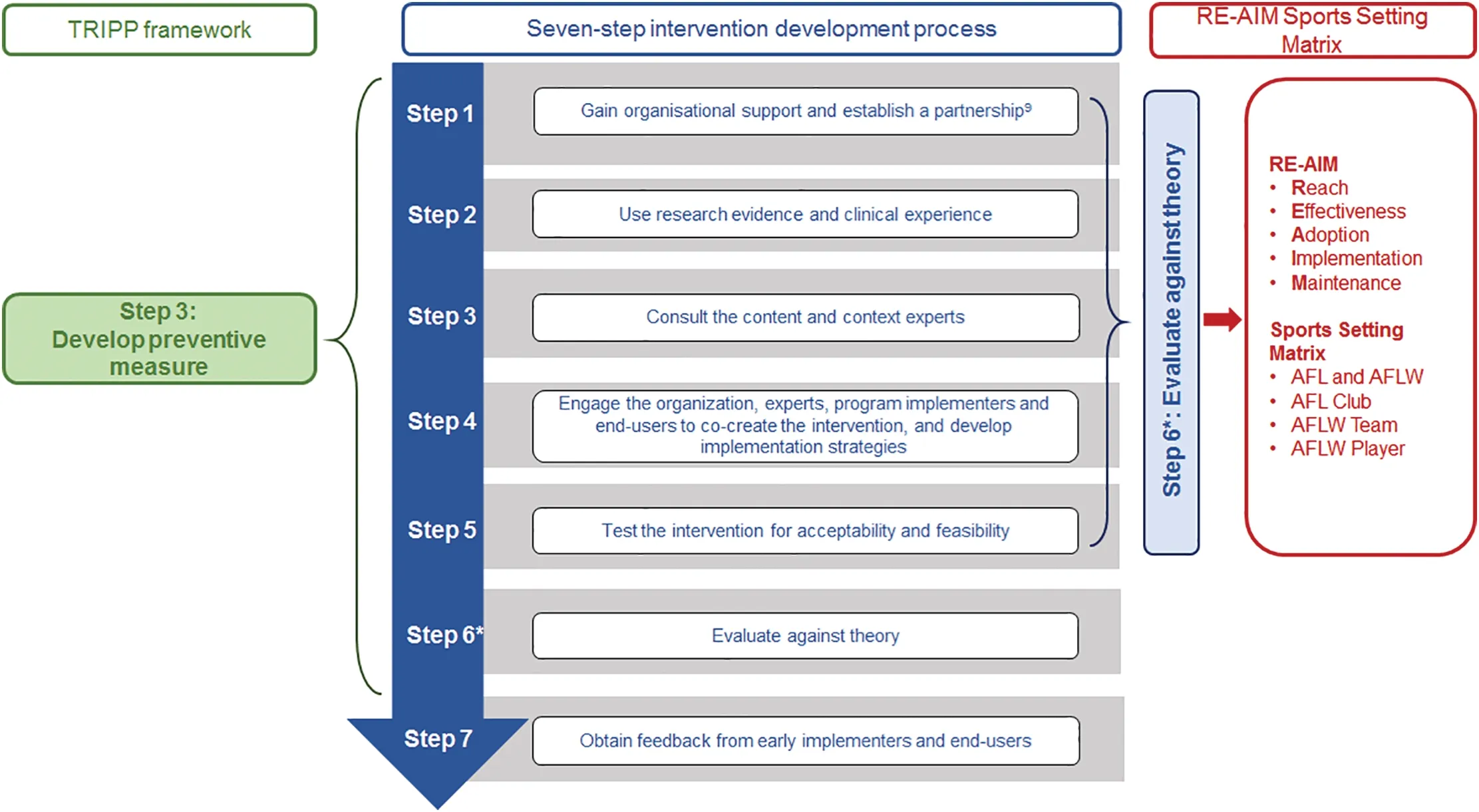
Fig.2.Modified 7-step intervention development process for the elite sport setting,16 aligned with the TRIPP13 and RE-AIM Sports Setting Matrix frameworks.23*Step 6 was applied as both an ongoing iterative review against the domains and levels of the RE-AIM Sports Setting Matrix during Step 1 to Step 5,and a one-off review of Prep to Play PRO at Step 6.AFL=Australian Football League;AFLW=Australian Football League for Women;RE-AIM=Reach Effectiveness Adoption Implementation Maintenance;TRIPP=Translating Research into the Injury Prevention Practice.TagedEnd
We adapted the 6-step process previously applied to plan16and develop15sports injury-prevention interventions to include an additional step(Fig.2).We made this adaptation to incorporate an additional initial step that would establish a partnership between the researchers and the organization(Step 1).11Three different research methods were used to inform the modified 7-step process for Prep to Play PRO:(1)a literature review to identify research evidence on injury-prevention programs in women’s soccer,5health behavior,and program implementation;(2)concept mapping with content and context experts to develop context-specific program content;25and(3)interviews and focus groups to identify implementer and enduser experiences,22preferences,and suggestions.
The RE-AIM SSM23guided program development.We used it as the theoretical framework to evaluate program creation(Step 6)and ongoing program review during development(Steps 1 through 5)to maximize the potential for program uptake in the AFLW.26The RE-AIM SSM operates across multiple ecological levels of the sports-delivery system.The 4 levels of the sports-delivery system relevant to this study were:the organization(the AFL/AFLW as governing body for the sport),the club(AFLW club administrators),the team(including the senior coach and support staff),and the athlete(AFLW player)(Fig.1).The RE-AIM SSM and the Socio-Ecological Model levels align in this study as follows:AFL/AFLW=community;club=organization;team=interpersonal;and AFLW athlete=individual.12,22
2.2.Data collection and analysis
Findings from our previously published systematic review,interviews with AFLW players,and concept mapping,respectively,informed Step 2,5Step 3,22and Step 4.25Semistructured interviews with 14 purposively selected injuryprevention experts working with elite women’s national sporting teams or AFLW clubs(10 medical/rehabilitation and 4 high-performance coaches)informed Step 3,Step 4,and Step 5.Nineteen players and 13 staff(6 medical/rehabilitation and 7 high-performance coaches)from 9 of 10 AFLW clubs were interviewed at the end of the 2019 AFLW season to inform Step 5 and Step 7.We selected these interviewees,who represent the individual/athlete and interpersonal/team socioecological levels,for their critical role in injury-prevention program coordination,delivery,and participation.Interviews were audio-recorded,transcribed verbatim,imported to NVivo qualitative data analysis software Version 12.6(QSR International Pty.,Melbourne,VIC,Australia),and analyzed using qualitative thematic analysis.27The study’s authors,who have clinical and research experience in sports-injury prevention,developed the interview guides(AMB,KMC,ABM,and AD)(Supplementary File 1).All interviews were conducted by a female member of the research team known to the participants,a sports physiotherapist experienced in working with elite team sport athletes(ABM),or a musculoskeletal physiotherapist experienced in women’s football team context(AMB).28To minimise differences in the quality of the interview interactions,ABM interviewed all experts working with elite women’s national sporting teams,and AMB interviewed all experts working with AFLW teams.Where participants expanded on responses that covered multiple questions,the interviewer omitted some questions from the interview guide.Qualitative thematic analysis using an inductive approach was undertaken.Emerging themes from these postseason interviews were triangulated with the findings from 141 AFLW player and 26 AFLW staff(2 assistant coaches,13 medical/rehabilitation,4 high-performance coaches,7 strength and conditioning coaches)online survey responses,using Qualtrics(Qualtrics,Provo,UT,USA)to enhance trustworthiness.29
Three national focus groups(90-120 min each)were held in separate Australian states(Victoria,Western Australia,and New South Wales).These were attended by 34 injury-prevention content and AFLW-context experts(21 physiotherapists,6 high-performance coaches,2 strength and conditioning coaches,2 sports physicians,and 3 AFLW players).Sessions were audio-recorded and facilitated by at least 4 research team members.A PowerPoint presentation with question prompts was used for each group,with suggestions and ideas from the previous group incorporated as discussion items in subsequent groups.All focus groups included a presentation of the concept mapping results,suggestions of the program content for each concept,and opportunities to discuss and provide feedback on:(1)concept mapping results and proposed program contents;(2)acceptability and feasibility of the proposed program for AFLW(informed Step 5);(3)terminology,presentation,and format of the proposed program;and(4)implementation barriers,facilitators,and context-specific strategies to enhance program uptake.Emerging themes were triangulated with recorded observations and attendees to inform Step 4 and Step 5.Modifications to education manuals were made in response to page-by-page feedback(Step 5 and Step 6)from 8 AFLW athletes and club personnel.
A 9-member AFL/AFLW coaching advisory team including AFL and AFLW national and state coaching development managers,AFL and AFLW assistant coaches,a former AFL head coach,sub-elite and community women’s coaches,and former sub-elite women’s players played a critical role in resource development and revision(Step 5).
Program use at the end of the 2019 AFLW season was defined as the use of all or one of Prep to Play PRO’s components.This was determined from AFLW player and support staff survey responses.
Our application of each of the program development steps,including the key activities aligned to the RE-AIM SSM,and outcomes of developing Prep to Play PRO are summarized in the results section and detailed in Supplementary Table 1.
3.Results
3.1.Step 1(November 2017-April 2018):Gain organizational support and establish a partnership
The governing body for the AFLW(the AFL)recognized the need to address the high incidence of ACL injuries in the AFLW as an organizational priority.An initial meeting between the AFL Head of Health,Safety and Laws(PC),a representative of the AFL Physiotherapist’s Association,and the research team established that the AFL considered injury prevention a priority in the AFLW(Supplementary Table 1).Regular communication,support,and endorsement from AFL staff throughout the 6 subsequent program development steps facilitated sustained buy-in across the system and embedded organizational priorities into the program.11This strong partnership was evident as the AFL provided financial,administrative,and creative support across all steps to investigate the problem,identify solutions,and create an AFLW-specific injury-prevention program.
3.2.Step 2(November 2017-October 2018):Use research evidence and clinical experience
We conducted a systematic search of the research literature and did not identify any published injury-prevention programs specifically for women’s elite AF.5However,clinical practice guidelines and our systematic review confirmed that an efficacious exercisebased program should be multicomponent,involve training multiple times per week,and be completed by everyone,all-yearround.5,7,30Given the difficulty of translating research into realworld sport settings,we also examined sports-injury implementation research to inform program design and implementation strategies.10-12,16,17,23,25,31-34The study’s key findings,including the types of movement awareness,strengthening,plyometric,agility and balance exercises,supervision,feedback mechanisms,and implementation strategies were summarized and collated into an Excel document.Seventeen players sustained an ACL injury during the 2017 AFLW preseason or inseason competition.We found 13(76%)of these ACL injuries occurred during(preseason or inseason)games.In the absence of evidence of the mechanism of ACL injuries specific to the AFLW,we analyzed video footage of 10(of 17)ACL injuries(Supplementary Table 1).Consistent with emerging evidence,35these injuries occurred during single-leg landing(n=2,20%),single-leg deceleration(n=3,30%),or a side-step task(n=5,50%).Of the 10 injuries,7 involved indirect contact,and 3 were noncontact injuries.
3.3.Step 3(March 2018-May 2018):Consult the content and context experts
Content and context experts across multiple socio-ecological levels(club,team,athlete)were involved in this step(Supplementary Table 1 and Supplementary File 1).Experts working with women playing on elite national sporting teams described their experiences using best-available injury-prevention program evidence.Thematic analysis identified the critical elements,structure,and implementation strategies for successful injury prevention in elite female athletes.Critical elements of these multicomponent programs included plyometrics(e.g.,explosive activities such as bounding),agility(e.g.,acceleration,deceleration,and change of direction),and balance(e.g.,jump with stabilisation with/without external perturbation).30Program dosage was higher than recommended guidelines.7Current practice included a warmup before training(45-90 min/week),separate strength training sessions(30-90 min/week),and specific injury prevention training(30-60 min/week).Implementation strategies included supervision by at least 1 professional skilled to provide feedback on movement and protected time embedded within training.30Professionals working in the AFLW identified many contextual implementation challenges,including a lack of in-session dedicated injury prevention time,limited resources(staff and equipment),limited football experience(including football-specific skills),lack of athlete talent development pathways,limited education to staff and athletes,and part-time athletes with competing demands.These findings are consistent with AFLW athletes’perspectives about the multilevel factors that influence injury-prevention program adoption and implementation.22Collectively,these findings support the need for an injury-prevention program that is:(1)AFLW specific;(2)supervised by experienced staff to provide feedback on movement;(3)underpinned by consistent principles across AFLW clubs;(4)flexible to individual player needs;and that(5)allows sufficient time for players to learn new skills and modify movement patterns.
3.4.Step 4(August 2018-November 2018):Engage the organization,experts,program implementers,and end-users to co-create the intervention and develop implementation strategies
The findings of our previous concept mapping25conducted with 27 ACL injury-prevention content and AFLW-context experts(22 physiotherapists and 5 AFLW players)identified the critical elements of an AFLW-specific injury-prevention program.We discussed the 5 essential components and their contents(from our previous study25)at 3 national focus groups(Supplementary Table 1).Lack of training time,poor access to players with competing personal and sporting demands,and limited resources were significant implementation considerations.Consequently,implementation strategies recommended by the focus group participants were:(1)embed the program throughout each training session(i.e.,not an added extra or a stand-alone program);(2)allow AFLW staff and elite athletes the flexibility to design specific activities,exercises,and drills to achieve program aims(e.g.,improvements in strength,balance,technique,etc.);(3)provide educational resources for athletes and coaches;and(4)gain AFL and peer-leader endorsement.
Review of audio recordings,observations from the focus group,and post-focus group team discussions informed the decision to integrate Prep to Play PRO throughout each training session as a flexible,dynamic strategy that meets AFLW team needs,rather than a structured,stand-alone injury-prevention program that replaces the warm-up only(Fig.3).36,37The principles underpinning Prep to Play PRO are that it should:(1)be AFLW player-specific,reflecting the context and constraints;(2)include all concepts consistent with efficacious injury-prevention programs;(3)recognize the novice skills of some athletes and the importance of learning fundamental football-specific skills;(4)incorporate a supervised stand-alone strength-training component;and(5)include print and video education for athletes and staff.
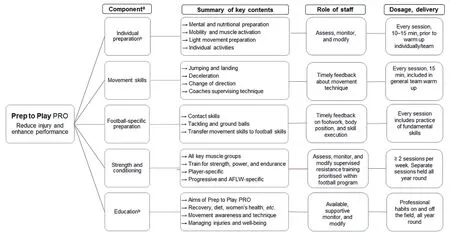
Fig.3.Summary of Prep to Play PRO.a Five components were from our concept-mapping exercise published separately.25 b Guided by medical,rehabilitation,and high-performance professionals,it may contain some or all activities.
3.5.Step 5(October 2018-March 2019):Test the intervention for acceptability and feasibility
To maximize implementer and end-user acceptability and feasibility,BEP(AFLW athlete)and MH(AFLW physiotherapist)applied their knowledge of the AFLW environment when drafting and revising the Prep to Play PRO content and resources.The program acceptability and feasibility-related findings from the concept mapping,individual interviews,and focus group discussions were incorporated into the first print-based draft of player and staff Prep to Play PRO manuals.Project team members and the AFL/AFLW coaching advisory team provided ongoing feedback about the movement and football-skills content(e.g.,jumping and landing,change of direction,deceleration,ground balls,and tackling)to ensure that it was relevant to and could be implemented in an AFLW club setting.Next,the AFL communications and creative team developed a program resource style and tone consistent with the AFLW marketing and education brand,which improved the readability and layout of the print manuals and may assist with player buy in.BEP and MH obtained program feedback from AFLW athletes,coaches,and support staff who suggested the following:program descriptions need to be clearer;more examples of drills are required;statistics should be simplified;photos should represent all AFL/AFLW clubs;and additional references should be included.Movement and football-skills video resources were produced in collaboration with the AFL,featuring current elite and subelite female AF players.Videos were planned and continually revised and edited throughout the filming stage,with input and feedback from the health and safety officer(PC),the coaching advisory team,and elite and semi-elite AFLW players.All resources(Supplementary Table 1 and Supplementary File 2)were branded Prep to Play PRO;included the AFL,AFLW,and University logos;and were accessible through a private weblink distributed to AFLW staff by the AFL.AFLW medical/rehabilitation staff and high-performance coaches negotiated with head and assistant coaches before the preseason to embed Prep to Play PRO in scheduled training.This included player and staff education sessions.The Head of AFL Women’s Football(NDL)launched Prep to Play PRO with a list of recommended actions.The 2019 AFLW season was composed of an 8-week preseason(starting in November 2018)and a 7-week,7 home/away game competition(February to April 2019),which served as the pilot period for program acceptability and feasibility(Step 5).
3.6.Step 6(August 2018-March 2019):Evaluate against theory
We continuously evaluated Prep to Play PRO and implementation activities against RE-AIM SSM23during Steps 1 through 5 and as a 1-off full review at Step 6(Fig.2).Fig.4 summarizes the questions and prompts used to reflect on each step of the process.These reflections enabled iterative revisions to optimize the intervention context-specificity to the AFLW.For example,in Step 1,endorsement at the organization level enabled access to AFLW staff and player contact details to maximize program awareness(reach)and invite them to participate in program development activities.Throughout program development,we communicated frequently with key stakeholders through multiple channels to ensure staff and players were aware of the program and its accompanying resources.Collaborating with the AFL helped us produce high-quality AFL-branded resources(Supplementary File 2)to address the variability in knowledge and to support individual learning and delivery preferences at the club,team,and player levels.
3.7.Step 7(December 2018-May 2019):Obtain feedback from early implementers and end-users
We obtained feedback about program use,acceptability,and implementation challenges before suggesting revisions at the end of the 2019 AFLW season.Preliminary program evaluation based on survey responses by coaches and players at the end of the 2019 season indicated that 9 of 10 AFLW used some or all parts of Prep to Play PRO.Although support staff from the tenth club participated in the program-development activities,they chose not to use Prep to Play PRO because they believed that they already included all program components in their current training.No changes to the 5 concepts underpinning the program were suggested.The education manuals were reported to be clear,assisted players to understand the importance of ACL injury prevention,and provided a framework for AFLW staff.Players enjoyed participating in most program components,particularly the movement and footballspecific skills.Lack of time and access to players before,during,and after the season,competing demands of part-time athletes,and lack of embedded education and injury-prevention measures across all levels of women’s AF were ongoing challenges.Education,prioritizing injury-prevention practices during and out-of-season,increasing the length of the competition season,and scheduling the AFLW season so it does not overlap with the start of subelite state-based competitions were consistent recommendations among AFLW players and staff(Supplementary Table 1).Plans were established with the AFL to address existing and anticipated future implementation challenges created by the rapid evolution of the AFLW competition and female participation at all AF levels.
4.Discussion
Prep to Play PRO was developed as a comprehensive sexand context-specific program guided by an established injury prevention development process.16It was developed in partnership with the AFL and through engagement with key stakeholders at multiple AFLW system levels.We designed the program in response to an urgent need identified by the AFL to address the high rate of ACL injuries in the AFLW and based on the knowledge that:(1)no sex(female)-and context(AFLW)-specific program was available;5(2)evidence-based injury-prevention programs are often poorly translated into real-world sport settings;31,38-40and(3)stakeholders at multiple levels of the sports delivery system13should participate throughout the program development and implementation planning processes.10,30,34This manuscript adds to the limited published literature that describes in detail the activities undertaken to develop an injury-prevention program for implementation in a real-world setting.16,17,41To the best of our knowledge,this is the first example of such a process in an elite sports setting.Therefore,it can serve as a guide and template for future sports-injury program development and implementation efforts.We will now discuss how applying this 7-step process resulted in Prep to Play PRO.
Gaining early organizational support and establishing a project partnership(Step 1)facilitated alignment with the AFL’s priorities and goals.30For example,the AFL’s concern about concussion rates in the first AFLW season drove the inclusion of tackling skills in the program.42Successful health-promotion intervention strategies require a link between resource systems,intermediate-user systems,and end-user systems.43This link is evident in the development of Prep to Play PRO,where the program developers(project/research team)were integrally and iteratively linked with the sport’s system(the AFL),decision makers and implementers(coaches,high-performance coaches,physiotherapists,etc.),and program participants(AFLW players).Each stakeholder group contributed important content and context knowledge throughout program development(Steps 3 through 7).Preliminary evidence suggests that integrating their perspectives in program development and implementation planning,along with the relationship among the AFL,the research team,and the AFLW clubs,were pivotal to enhancing program use.24The cooperation and contribution of knowledge and expertise by stakeholders across all levels of the sport’s system are particularly noteworthy,given the potential for stakeholders to protect intellectual property for competitive advantage in elite sport settings.
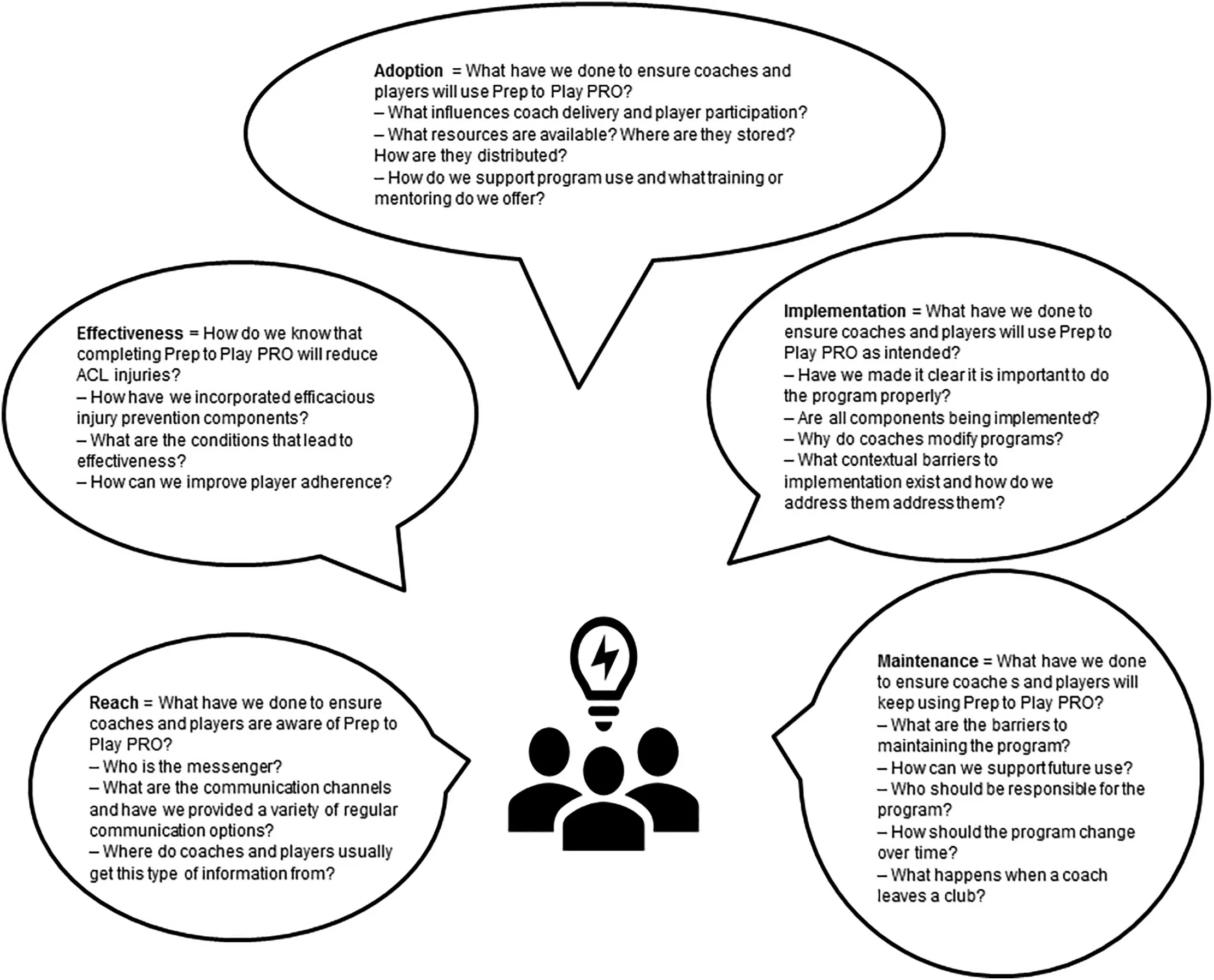
Fig.4.Questions and prompts linked to the RE-AIM Sports Setting Matrix framework to maximize program translation.12 ACL=anterior cruciate ligament;RE-AIM=Reach Effectiveness Adoption Implementation Maintenance.
Prep to Play PRO was embraced by the AFL and AFLW,coaches,and players because it included football-specific content(i.e.,tackling and ground ball technique).This important feature may have facilitated athlete buy-in to the injury prevention practices because it enabled integration into football training and a focus on enhancing AF performance.20Prep to Play PRO is not an“alternative warm-up”.It includes sport-specific skills,strength and conditioning,and athlete education as stand-alone program components.The program appealed to implementers because,unlike other prescriptive exercise-based injury-prevention programs,it is underpinned by training principles with examples of specific exercises.This enabled autonomy and flexibility for program deliverers(who tend to be very experienced and highly qualified physiotherapists and strength and conditioning staff)to maximize the program’s utility by creating activities and drills to suit the specific context requirements and the varying levels of skill and experience of their players.36
Small-scale acceptability and feasibility testing(Step 5)of the program and accompanying resources ensured that they were relevant for the varying levels of knowledge and football experience.The program’s education component appealed to athletes as it informed and empowered them.Providing education through print and e-version manuals,movement and skills videos,and practical sessions aimed to reach more athletes by catering to their learning and delivery preferences.Promoting AFL endorsement and partnership with the research team enhanced the program’s credibility and facilitated athlete and coach engagement.Strategies likely to have contributed to the success of the program,which was used by 9 of the 10 AFLW clubs in 2019,11included having the head of AFL Women’s Football launch the program,branding resources with organization logos,and featuring current elite and subelite female AF players.
Prep to Play PRO’s ultimate success will depend on widespread use and high-fidelity,sustained implementation in the AFLW.We are currently planning a multilevel process evaluation using multiple data sources to explore these issues.In conjunction with Step 7,these evaluation activities will provide perspectives and feedback from early implementers and end-users.
Prep to Play PRO was developed rapidly in response to the AFL’s organizational priority.This meant that the involvement of content and context experts,program implementers,and athletes was occasionally impeded during program development.During the off-season,access to players and staff was challenging,as players were not“in-contract”until a few weeks before preseason,some new(expansion)AFLW teams had not appointed staff,and some established teams had not confirmed staff.Many AFLW staff and players are part-time,and they often juggle competing personal,study,and work demands,which limited their opportunities to participate in program development activities.The lack of AFLW head coach involvement in program co-creation may be another limitation.Coaches could help to design sport-specific activities,thereby creating a sense of ownership and responsibility to ensure that movement quality is transferred into football-specific activities.Engaging coaches and support staff at nonelite levels would also be critical to ensure that Prep to Play PRO is adapted appropriately to address the contextual challenges in community settings.Despite this,by actively engaging stakeholders in all program-development steps and by establishing relationships early in the process,we ensured that there were multilevel,system-wide program advocates(organization,club/team,athlete)during program translation in the real-world setting.However,the short amount of time available for implementers to incorporate the program into their training practices may represent an additional implementation barrier.
5.Conclusion
Prep to Play PRO’s development is grounded in a partnership with the AFL.The AFL’s willingness to undertake critical activities and targeted strategies that engaged program designers,deliverers,and the athletes themselves throughout program development helped to create a context-specific injuryprevention program.The 7-step process used to develop Prep to Play PRO recognizes the need to engage with sporting organizations at all levels and to iteratively integrate content and context knowledge and expertise to develop and embed injury-prevention practices successfully.The processes and activities described in this article can serve as a guide and template for future sports-injury program-development and implementation efforts.
Acknowledgments
This work was supported by an AFL Research Board Grant(2018);La Trobe University Research Focus Area Grant(2018);La Trobe University Exercise and Medicine Research Centre.ABM is supported by a National Health and Medical Research Council(NHMRC)Early Career Fellowship(No.1156674).BEP is supported by a NHMRC Postgraduate Scholarship(No.1114296).The funding bodies had no role in the study design or in data collection,analysis,or interpretation.The authors would like to thank all participating athletes and staff for their invaluable contribution to this study.
Authors’contributions
KMC,BEP,PC,AMB,NDL,ABM,AD,and BFM conceived,planned,and designed the study,and drafted,revised,and edited the manuscript;MH assisted with data collection,development of program,and drafted,revised and edited the manuscript.All authors have read and approved the final version of the manuscript,and agree with the order of presentation of the authors.
Competing interests
KMC,AMB,ABM,and AD received research grants from the Australian Football League(AFL);BEP is a past athlete at an AFLW club and current assistant coach at an AFLW club;MH is a current physiotherapist at an AFLW club;NDL Medal of the Order of Australia(OAM)is employed by the AFL and is the Director of Swimming Australian LTD;PC was the past Chair of the AFL Research Board,which is responsible for the distribution of research grants.The other authors declare that they have no competing interests.
Supplementary materials
Supplementary materials associated with this article can be found in the online version at doi:10.1016/j.jshs.2021.09.003.
杂志排行
Journal of Sport and Health Science的其它文章
- The role of neurogranin in exercise-induced adaptation to brain
- Erratum to Can physical activity eliminate the mortality risk associated with poor sleep?A 15-year follow-up of 341,248 MJ Cohort participants[J Sport Health Sci 11(2022)596-604]
- A lateral ankle sprain during a lateral backward step in badminton:A case report of a televised injury incident
- Neurogranin as an important regulator in swimming training to improve the spatial memory dysfunction of mice with chronic cerebral hypoperfusion
- The moderating effect of physical activity on the relationship between bullying and mental health among sexual and gender minority youth
- The impact of height-adjustable desks and classroom prompts on classroom sitting time,social,and motivational factors among adolescents
